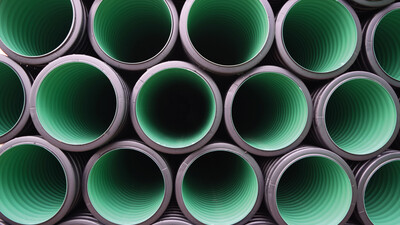You’ve probably heard of Twinwall drainage systems, but what are twinwall inspection chambers? Let’s dive in and take a look at them.
What do twinwall inspection chambers look like?
Like twinwall pipes, they are made from two HDPE sections, one welded inside the other. The inner section is smooth walled – on pipework, this allows for the smooth transition of water through the system – and the outer layer is corrugated.
As with twinwall pipe, these corrugations add strength and rigidity to the structure, making them more suitable than conventional single-wall HDPE inspection chambers for heavy-duty applications while still being considerably lighter, and more resilient, than concrete inspection chambers.
Where are twinwall inspection chambers used?
Twinwall inspection chambers are largely used as part of a complete twinwall drainage system, where resistance to ground movement caused by heavy traffic is anticipated and the inherent ability of HDPE to flex slightly rather than crack makes it preferable to concrete. One classic example of a suitable application for twinwall systems is at airports and railways, where land drainage systems must withstand the weight of heavy aircraft and trains, although twinwall systems are also widely used for roads and in the agricultural, commercial and leisure sectors.
How do you install a twinwall inspection chamber?
A twinwall inspection chamber should be installed in a pit that is at least 300mm larger in diameter than the chamber itself; this allows for the chamber to be surrounded by compacted backfill or granular bedding material of at least 150mm thickness.
Trafficked installation
For a trafficked installation, the pit should first be layered with compacted backfill and then the base of the chamber and all inlet or outlet pipes should be surrounded by granular bedding material. As you move up the sides of the chamber, surround the risers with granular bedding material or compacted backfill until you reach the top section of the inspection chamber.
The top section of the inspection chamber should be surrounded by granular bedding material or compacted backfill to a diameter of at least 600mm greater than that of the chamber’s outer diameter. A PCC cover slab or a concrete frame formed on site with a minimum 50mm gap between the chamber wall and the slab or frame should then be installed on top of the bedding or backfill, leaving enough space for a final layer of Class B engineering bricks or precast seating rings to hold the access cover in place flush with the surface.
Non-trafficked installation
For a non-trafficked installation, the chamber base should be set on a concrete base of a minimum thickness of 150mm and haunched at the sides to a minimum height of 75mm.
Granular bedding material at a minimum thickness of 150mm should be placed around the base of the inspection chamber and any inlet or outlet pipework. This, or compacted backfill, should be placed around the rest of the chamber to within 600mm of the surface and then extended to a diameter of at least 600mm greater than that of the chamber for the next 450mm of depth. The final 150mm can be backfilled with topsoil or other material to blend with the surrounding area.
Installation of chambers deeper than 1200mm
Any chamber that is deeper than 1200mm must be fitted with a restriction cap to comply with SfA7. Further details on installing a restriction cap can be found in our article “Inspection Chambers - How To Install Them Correctly”.
We hope you have found this information helpful and interesting. If you have any further questions you are always welcome to call the friendly team of drainage experts at Drainfast on 01420 555600 or email [email protected].
Also, look out for more articles in our ongoing series of blog posts, bringing you useful information, insights, guides and tips on all things drainage!

Written by
Mark Chambers
Marketing Manager
As Marketing Manager, Mark plays an active role in running strategic projects to increase our brand profile.

